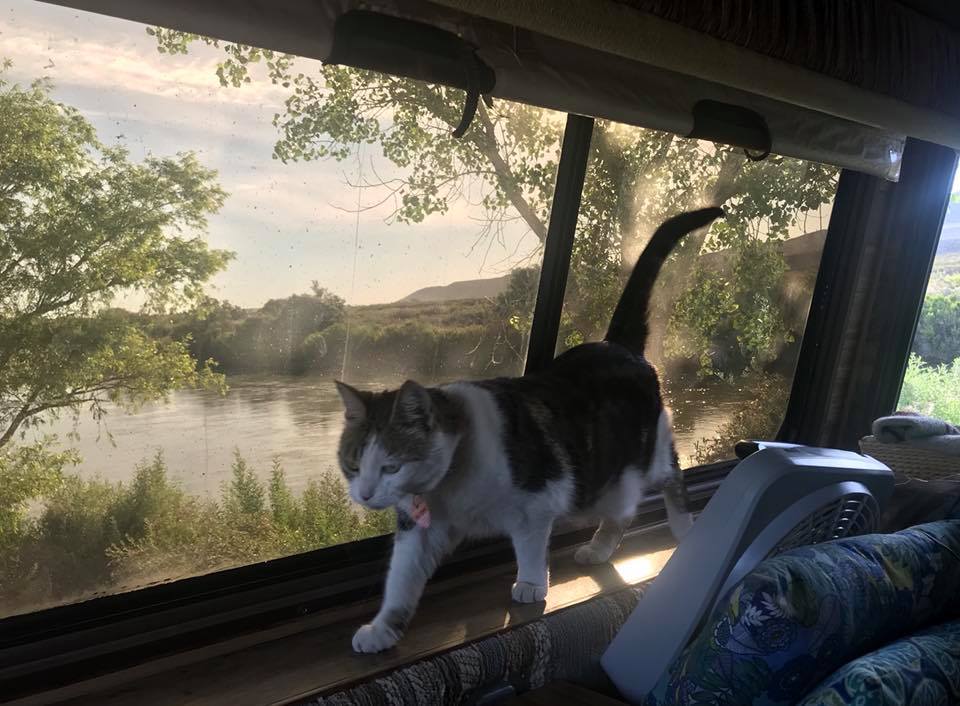Thanks for reading my blog! I appreciate your support! Maybe you’re wondering what other blogs you can read that are written by vandwellers, nomads, vagabonds, RVers, travelers, and drifters. Today I’ll share with you what I know about blogs written by folks who live on the road at least part of time.

Xsyntrik Nomad is written by my sweet and positive friend Devan Winters, a vandweller. She writes about choosing and building a van, earning a living on the road, and sharing her vanlife with a cat. She’s a very talented writer and her posts are quirky and engaging.
Yvette Angela Assata writes Rated Rosa, and says of herself,
I am a radical Black feminist, birth worker, activist, anti-racist, a lesbian, and I do a whole lot of community organizing…
…I decided I would convert a school bus to live in, and while I was at it, travel North America. The choice to move onto a vehicle was an easy decision for me because it fits my lifestyle. Besides living in the Pacific Northwest for the past near-13 years, seeing the increases in rent and gentrified neighborhoods, watch people not able to find housing (myself included) and literally pushed out of cities and into the margins, I’m anti-establishment and a wanderer to my core.
Brenton MacAloney has been writing Brent’s Travels since 2013. He’s traveled in a camper van, a Toyota Prius, and a pickup truck with a camper that slides into the van. He says,
I like travel, meeting people, and writing about my experiences.Meeting people is a goal of mine. In fact I will try to meet someone new everyday. I want to write about them. Who [they] are and what makes them unique.
Undercover Hippy Bus is about a family living in “big white ex-courier van.” The adults were tired of all the time their jobs stole away from being with their kids, so they sold off most of their stuff and now live simply and happily. They write about parenting, food, and travels.
Make Like an Apeman is about Duwan and Greg, nomads since 2011. They say,
…we sold everything, quit our jobs, rented our house (and eventually sold it), bought a sailboat, and set sail on a traveling adventure and a story that has been writing itself as we go along.
Their Instagram account (@makelikeanapeman) says they now live in a van three seasons a year and house sit in the summers.
Burly Nomads is the blog of
Miah and George, a gay couple [who recently started their] adventure into full-time RV living. We are tired of being tied down to a house that we do not like, nor want to be in. Tired of not being able to travel to places we want to see, visit with friends and family we want to visit, so we are choosing to have a life of ‘Freedom over Stability’

The RV Artsy Life of Sue Soaring Sun is written by my friend and Sun sister. She writes about the art she creates and the places she visits with her cat Sonja Begonia while living in Brownie, her 20-ft 1984 Lazy Daze mini-motor home. Sue doesn’t update her blog often, but when she does, I really enjoy her stories from the road.
Gnomad Home is the place to go to read about the adventures of John and Jayme and their two dogs. It’s also an outstanding place to get tons of tips to make your van life easier and more enjoyable. There is an excellent section called Build Your Van with so much helpful information
all about helping you…choose your van, plan your design, install creature comforts like electricity and plumbing, and actually build out the interior of your DIY campervan conversion. [Y]ou’ll find awesome infographics, detailed information, step-by-step guides, links to helpful resources, and more.
Kaya Lindsay’s blog can be found at One Chick Travels. Kaya says of herself,
I am a writer, I am a photographer, I am a filmmaker, I am a climber, I play the ukulele and I drive long distances as a form of self-care…
I have been living in my 2006 Dodge Sprinter Van and creating content for about 2 years. I drive around, rock climb, play the ukulele
and interview badass lady travelers who are also living in vans.
Interstellar Orchard is the blog of Becky Schade who started living on the road full-time in 2012, at the age of 28. Becky says,
Here at Interstellar Orchard (IO), you’ll find:
Informational articles on how to go RVing full-time
Travelogues of my adventures to inspire future nomads and armchair travelers alike
Philosophical posts on how to live a happier, more fulfilling life










 Delilah began to run out, and we called her to come back. She immediately stopped, turned around and sprinted back to us! Now, anytime we go into the woods and let her off leash, she tends to stay within ear shot. Delilah and Nymeria never adventure too far, we can typically see or hear them (they each have a bear bell on their collars, as well as lights that can be turned on to a solid or flashing light), and the second we call for them they happily trot on back to us.
Delilah began to run out, and we called her to come back. She immediately stopped, turned around and sprinted back to us! Now, anytime we go into the woods and let her off leash, she tends to stay within ear shot. Delilah and Nymeria never adventure too far, we can typically see or hear them (they each have a bear bell on their collars, as well as lights that can be turned on to a solid or flashing light), and the second we call for them they happily trot on back to us.